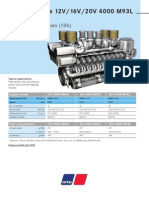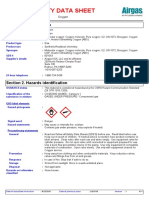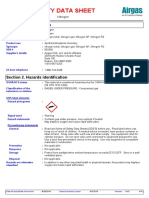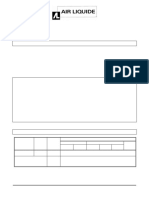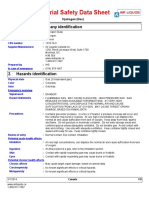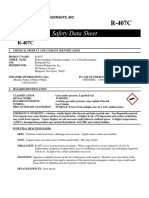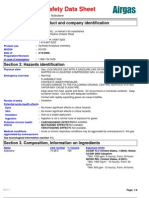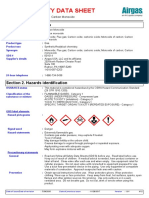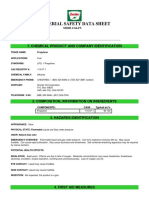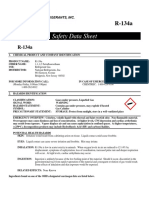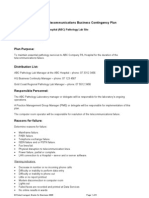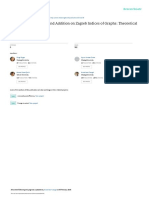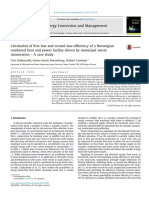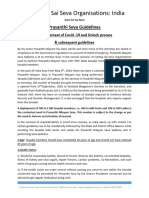Nitrogen SDS
Nitrogen SDS
Uploaded by
Judin MathewsCopyright:
Available Formats
Nitrogen SDS
Nitrogen SDS
Uploaded by
Judin MathewsCopyright
Available Formats
Share this document
Did you find this document useful?
Is this content inappropriate?
Copyright:
Available Formats
Nitrogen SDS
Nitrogen SDS
Uploaded by
Judin MathewsCopyright:
Available Formats
MESA Specialty Gases & Equipment
2427 S. Anne Street
Santa Ana, California 92704 USA
Domestic US: (866) 470-6372; International 714-434-7102
www.mesagas.com
SAFETY DATA SHEET
SECTION 1 – IDENTIFICATION
Chemical Name: Nitrogen
Chemical Formula: N2
Chemical Family: Inert Gas
Hazard Classification: Nitrogen, Compressed, Non-Flammable Gas, UN1066,
Green Label
Product Use Description: Analytical Standard and General Laboratory Applications
Company: MESA Specialty Gases & Equipment
2427 South Anne Street
Santa Ana, California 92704 USA
Phone Number for Information: Infotrac
Emergency Contact: 800-535-5053 (Int’l: 352-323-3500)
SECTION 2 – HAZARD(S) IDENTIFICATION
SIGNAL WORD - WARNING
HAZARD STATEMENTS: Contains gas under pressure; may explode if heated.
May cause suffocation by displacing oxygen in the air.
PRECAUTIONARY STATEMENTS:
General: Use in accordance with Safety Data Sheets.
Do not ingest or inhale. Avoid contact with skin and clothing.
Prevention: Keep away from heat, hot surfaces, sparks, open flames,
and other ignition sources. No smoking.
Response: Leaking gas fire: Do not extinguish unless leak can be stopped safely.
In case of leakage, eliminate all ignition sources.
Do not open valve until prepared to use.
Always use a back flow preventative device in piping.
Storage: Protect from sunlight. Store in a well-ventilated place.
OTHER HAZARDS: High pressure gas. May cause rapid suffocation.
May cause dizziness, nausea, drowsiness, vomiting, excess
salivation, loss of mobility/consciousness.
May react explosively even in absence of air at elevated pressure
and/or temperature.
Self-contained breathing apparatus (SCBA) may be required.
MESA Specialty Gases Equipment Page 1 of 8 11/26/2018
SECTION 3 – COMPOSITION/INFORMATION ON INGREDIENTS
COMPONENT CAS NO. CONCENTRATION
Nitrogen 7727-37-9 99.999%
Maximum impurities including Hydrocarbons,
Carbon Monoxide, Carbon Dioxide, Oxygen 0.001% (10 ppm)
SECTION 4 – FIRST AID MEASURES
ROUTE OF EXPOSURE:
Inhalation: Remove person to uncontaminated area. SCBA may be required to prevent asphyxiation of rescue workers.
Keep warm and at rest. Lay victim face down with head and chest lower than hips to improve drainage from lungs. If
breathing is labored, administer pure oxygen. If breathing has stopped, start artificial respiration. Get immediate medical
attention for serious exposure.
Eye contact: N/A
Skin contact: N/A
Ingestion: N/A
SYMPTOMS: High concentrations of this gas can cause an oxygen-deficient environment. Individuals breathing such an
atmosphere may experience symptoms which include headaches, ringing in ears, dizziness, drowsiness, unconsciousness,
nausea, vomiting, and depression of all the senses. The skin of a victim may have a blue color. Under some
circumstances, death may occur. The effects associated with various levels of oxygen are as follows:
CONCENTRATION SYMPTOMS OF EXPOSURE NITROGEN GAS
12-16% Oxygen: Breathing and pulse rate increased, muscular
coordination slightly disturbed. HAZARDOUS MATERIAL INFORMATION
10-14% Oxygen: Emotional upset, abnormal fatigue, disturbed SYSTEM
respiration.
6-10% Oxygen: Nausea and vomiting, collapse or loss of HEALTH (BLUE) 1
consciousness.
Below 6%: Convulsive movements, possible respiratory
collapse, and death.
OTHER POTENTIAL HEALTH EFFECTS: Contact with cryogenic
FLAMMABILITY (RED) 0
liquid or rapidly expanding gases (which are released under high
pressure) may cause frostbite. Symptoms of frostbite include
change in skin color to white or grayish-yellow. The pain after
contact with liquid can quickly subside.
REACTIVITY (YELLOW) 0
HEALTH EFFECTS OR RISKS FROM EXPOSURE: An Explanation
PROTECTIVE EQUIPMENT B
in Lay Terms. Overexposure to Nitrogen may cause the following
health effects:
EYES RESPIRATORY HANDS BODY
ACUTE: The most significant hazard associated with this gas is
inhalation of oxygen-deficient atmospheres. Symptoms of oxygen See See
deficiency include respiratory difficulty, headache, dizziness and Section 8 Section 8
nausea. At high concentrations, unconsciousness or death may
occur. Contact with cryogenic liquid or rapidly expanding gases For routine industrial applications
may cause frostbite.
CHRONIC: There are currently no known adverse health effects associated with chronic exposure to Nitrogen.
TARGET ORGANS: Respiratory system.
MESA Specialty Gases Equipment Page 2 of 8 11/26/2018
SECTION 5 – FIRE FIGHTING MEASURES
NITROGEN GAS
EXTINGUISHING MEDIA: Non-flammable, inert gas. Use extinguishing media NFPA RATING
appropriate for surrounding fire. FLAMMABILITY
UNUSUAL FIRE AND EXPLOSION HAZARDS: Nitrogen does not burn; however,
containers may rupture violently when exposed to fire. Continue to cool fire exposed
0
cylinders until flames are extinguished. Cylinder valve is equipped with a pressure
relief device to safely vent the cylinder if it is exposed to elevated pressure in a fire.
HEALTH 1 0 REACTIVITY
SPECIAL FIRE FIGHTING PROCEDURES: Structural fire-fighters must wear Self-
Contained Breathing Apparatus and full protective equipment. Move fire-exposed
cylinders if it can be done without risk to firefighters. Otherwise, cool containers with
OTHER
hose stream and protect personnel. Withdraw immediately in case of rising sounds
from venting safety device or any discoloration of tanks due to the fire.
SECTION 6 – ACCIDENTAL RELEASE MEASURES
PERSONAL PRECAUTIONS, PROTECTIVE EQUIPMENT, AND EMERGENCY PROCEDURES: Wear self-contained
breathing apparatus when entering area unless atmosphere is proved to be safe. Monitor oxygen level. Ventilate the area.
SPILL AND LEAK RESPONSE: Uncontrolled releases should be responded to by trained personnel using pre-planned
procedures. Proper protective equipment should be used. In case of a release, clear the affected area and protect people.
Minimum Personal Protective Equipment should be Level B: protective clothing, mechanically-resistant gloves and Self-
Contained Breathing Apparatus. Locate and seal the source of the leaking gas. Allow the gas to dissipate. Monitor the
surrounding area for oxygen levels. The atmosphere must have at least 19.5 percent oxygen before personnel can be
allowed in the area without Self-Contained Breathing Apparatus. Attempt to close the main source valve prior to entering
the area. If this does not stop the release (or if it is not possible to reach the valve), allow the gas to release in-place or
remove it to a safe area and allow the gas to be released there.
ENVIRONMENTAL PRECAUTIONS: Prevent spreading of vapors through sewers, ventilation systems, and confined areas.
Do not discharge materials into any place where their accumulation could be dangerous.
METHODS AND MATERIALS FOR CONTAINMENT AND CLEANING UP: Stop the folow of gas or remove cylinder to
outdoor location if this can be done without risk. Ventilate enclosed areas. Move leaking cylinder to fume hood or safe
outdoor area. Use monitoring equipment if hazardous conditions are suspected or likely to occur.
MESA Specialty Gases Equipment Page 3 of 8 11/26/2018
SECTION 7 – HANDLING AND STORAGE
PRECAUTIONS FOR SAFE HANDLING: Only experienced and properly instructed persons should handle compressed
gases. Person is to know and understand the properties and hazards of the product before use. Do not remove or deface
labels provided by the supplier for the identification of the product.
Protect cylinders against physical damage. Store in cool, dry, well-ventilated, fireproof area, away from flammable materials
and corrosive atmospheres. Store away from heat and ignition sources and out of direct sunlight. Do not store near
elevators, corridors or loading docks. Do not allow area where cylinders are stored to exceed 52°C (125°F). Isolate from
incompatible materials such as magnesium (see Section 10, Stability and Reactivity for more information), which can react
violently. Use only storage containers and equipment (pipes, valves, fittings to relieve pressure, etc.) designed for the
storage of Liquid Nitrogen. Do not store containers where they can come into contact with moisture. Cylinders should be
stored upright and be firmly secured to prevent falling or being knocked over. Cylinders can be stored in the open, but in
such cases, should be protected against extremes of weather and from the dampness of the ground to prevent rusting.
Keep Dewar flasks covered with loose fitting cap. This prevents air or moisture from entering the container, yet allows
pressure to escape. Use only the stopper or plug supplied with the container. Ensure that ice does not form in the neck of
flasks. If the neck of Dewar flask is blocked by ice or “frozen” air, follow manufacturer’s instruction for removing it. Ice can
also cause pressure release valves to fail. Never tamper with pressure relief devices. The following rules are applicable to
situations in which cylinders are being used:
Before Use: Move cylinders with a suitable hand-truck. Do not drag, slide or roll cylinders. Do not drop cylinders or permit
them to strike each other. Secure cylinders firmly. Leave the valve protection cap in-place (if provided), until cylinder is
ready for use.
During Use: Use designated CGA fittings and other support equipment. Do not use adapters. Do not heat cylinder by any
means to increase the discharge rate of the product from the cylinder. Use check valve or trap in discharge line to prevent
hazardous backflow into the cylinder. Do not use oils or grease on gas-handling fittings or equipment.
After Use: Close main cylinder valve. Replace valve protection cap (if provided). Mark empty cylinders “EMPTY”.
NOTE: Use only DOT or ASME code containers. Earth-ground and bond all lines and equipment associated with this
product. Close valve after each use and when empty. Cylinders must not be recharged except by or with the consent of
owner. For additional information refer to the Compressed Gas Association Pamphlet P-1, Safe Handling of Compressed
Gases in Containers. For cryogenic liquids, refer to CGA P-12, Safe Handling of Cryogenic Liquids. Also see CGA P-9, the
Inert Gases, Argon, Nitrogen, and Helium; CGA P-14, Accident Prevention in Oxygen Rich and Oxygen Deficient
Atmospheres; CGA Safety Bulletin SB-2, Oxygen Deficient Atmospheres.
CONDITIONS FOR SAFE STORAGE: Cylinders should be secured with mounting brackets away from heavily traveled
areas. Use oldest cylinders in stock first to prevent full cylinders from being stored for excessive periods of time. Full and
empty cylinders should be segregated. Keep cylinder in dry, cool, well ventilated area away from heat, flame, sparks or
corrosive chemicals. Cylinders should be moved by suitable hand trucks. Close valve after each use and when
empty.Cylinder valve guards or caps should be in place. Cylinder temperature should not exceed 52°C (125°F). Store
containers in location free from fire risk and away from any sources of heat and ignition. Keep cylinder away from
combustible material. Use equipment rated for cylinder pressure.
MESA Specialty Gases Equipment Page 4 of 8 11/26/2018
SECTION 8 – EXPOSURE CONTROLS/PERSONAL PROTECTION
COMPONENT OSHA PEL ACGIH TLV
Nitrogen None None
APPROPRIATE ENGINEERING CONTROLS: Use with adequate ventilation to maintain oxygen levels above 19.5% in the
workplace. Local exhaust ventilation is preferred, because it prevents Nitrogen dispersion into the work place by eliminating
it at its source. If appropriate, install automatic monitoring equipment to detect the level of oxygen.
INDIVIDUAL PROTECTIVE MEASURES: Safety glasses, work gloves, and safety shoes should be worn when handling
high pressure cylinders or hazardous materials.
RESPIRATORY PROTECTION: Maintain oxygen levels above 19.5% in the workplace. Use supplied air respiratory
protection if oxygen levels are below 19.5% or during emergency response to a release of Nitrogen. If respiratory protection
is required, follow the requirements of the Federal OSHA Respiratory Protection Standard (29 CFR 1910.134), or equivalent
State standards.
EYE PROTECTION: Splash goggles, face-shields or safety glasses. Face-shields must be worn when handling cryogenic
Nitrogen.
HAND PROTECTION: Wear mechanically resistant-gloves when handling cylinders of Nitrogen. Use low-temperature
protective gloves (e.g., Kevlar) when working with containers of Liquid Nitrogen.
BODY PROTECTION: Use body protection appropriate for task. Transfer of large quantities under pressure may require
protective equipment appropriate to protect employees from splashes of liquefied product, as well provide sufficient
insulation from extreme cold.
SECTION 9 – PHYSICAL AND CHEMICAL PROPERTIES
Appearance: Colorless Upper/lower flammability/explosive limits: No data available
Odor: Odorless Vapor Pressure: N/A
Odor threshold: No data available Vapor Density (Air=1): 1.153 kg/m3 (0.072 lb/ft3)
pH: N/A Relative Density (Water=1): Varies
Melting point/range: N/A Solubility (in water): 1.49%
Boiling point/range: -320.4°F (-195.8°C) Partition coefficient (n-octanol/water): N/A
Flash Point: N/A Auto-ignition temperature: No data available
Evaporation Rate (Butyl Acetate=1): N/A Decomposition temperature: No data available
Flammability (solid, gas): No data available Visocity: N/A
SECTION 10 – STABILITY AND REACTIVITY DATA
Conditions to avoid: Contact with incompatible materials.
Reactivity: Refer to possibility of hazardous Cylinders exposed to high temperatures or direct flame can rupture
reactions and/or incompatible materials sections or burst.
Incompatible materials: Titanium, neodymium, lithium, zirconium
and ozone react with Nitrogen. Calcium, strontium, and barium will
Chemical Stability: Normally stable in gaseous react with red heat to form nitrides. Hydrogen reacts on sparking to
state form ammonia.
Possibility of hazardous reactions: No data Hazardous Decomposition or Byproducts: None
available
MESA Specialty Gases Equipment Page 5 of 8 11/26/2018
SECTION 11 – TOXICOLOGICAL INFORMATION
LIKELY ROUTES OF EXPOSURE:
Eye Irritation (rabbit): Liquid Nitrogen poured into the eye for one or two seconds with the lids held apart, produced no
discernible injury. When the exposure was extended to five seconds, slight lesions of the cornea were observed. By the
next day, all eyes were entirely normal.
SYMPTOMS/EFFECTS FROM EXPOSURE:
SYMPTOMS: High concentrations of this gas can cause an oxygen-deficient environment. Individuals breathing such an
atmosphere may experience symptoms which include headaches, ringing in ears, dizziness, drowsiness, unconsciousness,
nausea, vomiting, and depression of all the senses. The skin of a victim may have a blue color. Under some
circumstances, death may occur. The effects associated with various levels of oxygen are as follows:
CONCENTRATION SYMPTOMS OF EXPOSURE
12-16% Oxygen: Breathing and pulse rate increased, muscular coordination slightly disturbed.
10-14% Oxygen: Emotional upset, abnormal fatigue, disturbed respiration.
6-10% Oxygen: Nausea and vomiting, collapse or loss of consciousness.
Below 6%: Convulsive movements, possible respiratory collapse, and death.
OTHER POTENTIAL HEALTH EFFECTS: Contact with cryogenic liquid or rapidly expanding gases (which are released
under high pressure) may cause frostbite. Symptoms of frostbite include change in skin color to white or grayish-yellow.
The pain after contact with liquid can quickly subside.
HEALTH EFFECTS OR RISKS FROM EXPOSURE: An Explanation in Lay Terms. Overexposure to Nitrogen may cause
the following health effects:
ACUTE: The most significant hazard associated with this gas is inhalation of oxygen-deficient atmospheres. Symptoms of
oxygen deficiency include respiratory difficulty, headache, dizziness and nausea. At high concentrations, unconsciousness
or death may occur. Contact with cryogenic liquid or rapidly expanding gases may cause frostbite.
CHRONIC: There are currently no known adverse health effects associated with chronic exposure to Nitrogen.
TARGET ORGANS: Respiratory system.
ACUTE/CHRONIC TOXICITY: No data available.
CARCINOGENICITY: No data available.
SECTION 12 – ECOLOGICAL INFORMATION
Ecotocity (aquatic and terrestrial): Any adverse effect on animals would be related to oxygen deficient environments.
No adverse effect is anticipated to occur to plant-life, except for frost produced in the presence of rapidly expanding gases.
No evidence is currently available on the effects of Nitrogen on aquatic life.
Persistence and degradability: No data available
Bioaccumulative potential: No data available
Mobility in soil: No data available
Other Effects: The mixture does not contain any class I or Class II ozone depleting chemicals.
SECTION 13 – DISPOSAL CONSIDERATIONS
Disposal: Waste disposal must be in accordance with appropriate National, Federal, State, and local regulations. Do not
dispose or discharge into the environment. Do not discharge into enclosed environment. Contact supplier if additional
guidance is required.
MESA Specialty Gases Equipment Page 6 of 8 11/26/2018
SECTION 14 – TRANSPORTATION INFORMATION
DOT Classification:
Proper Shipping Name: Nitrogen, compressed
Class: 2.2
UN/ID No.: UN1066
Label: Non-Flammable Gas, Green Label
IATA Classification:
Proper Shipping Name: Nitrogen, compressed
Class: 2.2
UN/ID No.: UN1066
Label: Non-Flammable Gas, Green Label
Environment hazard: No
Transport in bulk (according to Annex II of MARPOL 73/78 and the IBC Code: N/A
SPECIAL PRECAUTIONS FOR USER: Avoid transport on vehicles where the load space is not separated from driver's
compartment. Ensure that transporter is aware of the potential hazards of the load and knows what to do in event of an
emergency. Contact supplier for complete transportation information.
SECTION 15 – REGULATORY INFORMATION
U.S. SARA REPORTING REQUIREMENTS: Nitrogen is not subject to the reporting requirements of Sections 302, 304, and
313 of Title III of the Superfund Amendments and Reauthorization Act.
U.S. CERCLA REPORTABLE QUANTITY (RQ): Not applicable.
CANADIAN DSL/NDSL INVENTORY STATUS: Nitrogen is on the DSL Inventory.
U.S. TSCA INVENTORY STATUS: Nitrogen is on the TSCA Inventory.
OTHER U.S. FEDERAL REGULATIONS: Not applicable.
U.S. STATE REGULATORY INFORMATION: Nitrogen is covered under the following specific State regulations:
Alaska - Designated Toxic and Hazardous Substances: No. California - Permissible Exposure Limits for Chemical
Contaminants: Nitrogen. Florida - Substance List: No. Illinois - Toxic Substance List: No.
Kansas - Section 302/313 List: No. Massachusetts - Substance List: No. Michigan - Critical Materials Register: No.
Minnesota - List of Hazardous Substances: No. Missouri - Employer Information/Toxic Substance List: No. New Jersey -
Right to Know Hazardous Substance List: Nitrogen.
North Dakota - List of Hazardous Chemicals, Reportable Quantities: No. Pennsylvania - Hazardous Substance List:
Nitrogen. Rhode Island - Hazardous Substance List: Nitrogen. Texas - Hazardous Substance List: No. West Virginia -
Hazardous Substance List: No. Wisconsin - Toxic and Hazardous Substances: No.
LABELING (For Compressed Gas):
WARNING: CONTAINS GAS UNDER PRESSURE; MAY EXPLODE IF HEATED. MAY CAUSE RAPID SUFFOCATION BY
DISPLACING OXYGEN IN THE AIR. MAY INCREASE RESPIRATION AND HEART RATE. May cause dizziness, nausea,
drowsiness, vomiting, excess salivation, and loss of mobility/consciousness. May cause frostbite. Keep away from heat, hot
surfaces, sparks, open flames and other ignition sources—No smoking. Use and store in well-ventilated areas. Leaking gas
fire: Do not extinguish unless leak can be stopped safely. In case of leakage, eliminate all ignition sources. Do not open
valve until prepared to use. Always use a backflow preventative device in piping. Use only with equipment rated for cylinder
pressure. Close valve after each use and when empty. Cylinder temperature should not exceed 52°C (125°F). Use in
accordance with Safety Data Sheet. FIRST AID: IF INHALED, remove to fresh air. If breathing is difficult, give Oxygen. Call
a physician. IN CASE OF FROSTBITE, obtain immediate medical attention. DO NOT REMOVE THIS LABEL.
MESA Specialty Gases Equipment Page 7 of 8 11/26/2018
SECTION 16 – OTHER INFORMATION
Information contained in this data sheet is offered without charge for use by technically qualified personnel at their
discretion and risk. All statements, technical information and recommendations contained herein are based on tests and
data which we believe to be reliable. But the accuracy and completeness thereof, is not guaranteed and no warranty of
any kind, either expressed or implied, is made with respect thereto. Since MESA Specialty Gases and Equipment Division
of MESA International Technologies, Inc. shall have no control over the use of the product described herein, we assume
no liability for loss or damage incurred from the proper or improper use of such product.
HISTORY:
Date of printing: 11/26/2018
Date of issue/revision: 11/26/2018
Date of previous issue: 12/1/2014
DISCLAIMER
Information contained in this data sheet is offered without charge for use by technically qualified personnel at their discretion and risk. All
statements, technical information and recommendations contained herein are based on tests and data which we believe to be reliable.
But the accuracy and completeness thereof, is not guaranteed and no warranty of any kind, either expressed or implied, is made with
respect thereto. Since MESA Specialty Gases and Equipment Division of MESA International Technologies, Inc. shall have no control
over the use of the product described herein, we assume no liability for loss or damage incurred from the proper or improper use of such
product.
MESA Specialty Gases Equipment Page 8 of 8 11/26/2018
You might also like
- Mtu 12V 4000Document2 pagesMtu 12V 4000elavayen0% (1)
- Nitrogen AmerexDocument9 pagesNitrogen Amerexharanus2000No ratings yet
- Msds Nitros Oxide GasDocument11 pagesMsds Nitros Oxide GasReniNo ratings yet
- Nitrous OxideDocument11 pagesNitrous Oxiderozeena.baig123No ratings yet
- MSDS Dufont Fe 36 ServvoDocument8 pagesMSDS Dufont Fe 36 ServvoNasrulNo ratings yet
- Safety Data Sheet: Section 1. IdentificationDocument11 pagesSafety Data Sheet: Section 1. IdentificationRam1zNo ratings yet
- Safety Data Sheet: Section 1. IdentificationDocument11 pagesSafety Data Sheet: Section 1. IdentificationDan AlbertNo ratings yet
- No+n2 MSDSDocument15 pagesNo+n2 MSDSDurga RamanjaneyuluNo ratings yet
- Msds NitrogenDocument10 pagesMsds NitrogenNga JengjeheNo ratings yet
- MSDS Gaseous ArgonDocument8 pagesMSDS Gaseous ArgonGrd GrdNo ratings yet
- Msds 1301 RemtecDocument5 pagesMsds 1301 RemtecJeremy KumarNo ratings yet
- MSDS Sodium NitriteDocument5 pagesMSDS Sodium NitritemarcNo ratings yet
- MSDS N2Document6 pagesMSDS N2Achmad Nur HusainiNo ratings yet
- Hydrogen MSDSDocument9 pagesHydrogen MSDSSyifaBahiijAmalia100% (1)
- SDS R32Document8 pagesSDS R32AdiNo ratings yet
- Terex 3303b Parts BookDocument7 pagesTerex 3303b Parts BookRavinder SinghNo ratings yet
- Honeywell Genetron R407CDocument16 pagesHoneywell Genetron R407CvivekNo ratings yet
- Blue Shield 11 MsdsDocument7 pagesBlue Shield 11 MsdssalcabesNo ratings yet
- Material Safety Data Sheet: Section 1. Chemical Product and Company IdentificationDocument6 pagesMaterial Safety Data Sheet: Section 1. Chemical Product and Company IdentificationHenry OdulioNo ratings yet
- AIR LIQUIDE (MSDS) GAS-METHANE Expires 17-07-02Document9 pagesAIR LIQUIDE (MSDS) GAS-METHANE Expires 17-07-02PubcrawlNo ratings yet
- Nitrous OxideDocument8 pagesNitrous OxideFa RaNo ratings yet
- Msds IsobutanaDocument11 pagesMsds IsobutananikoNo ratings yet
- Liquide Udara PDFDocument8 pagesLiquide Udara PDFYovaniNissiMKetarenNo ratings yet
- Gas CylinderDocument9 pagesGas CylinderKidry RobleroNo ratings yet
- Material Safety Data Sheet: 1. Chemical Product and Company IdentificationDocument7 pagesMaterial Safety Data Sheet: 1. Chemical Product and Company IdentificationVo Anh HaoNo ratings yet
- SDS R1234zeDocument15 pagesSDS R1234zeRafaelDutraNo ratings yet
- Chloreathyl SprayDocument9 pagesChloreathyl SprayPutri Adin KiranaNo ratings yet
- Material Safety Data Sheet: 1. Product and Company IdentificationDocument8 pagesMaterial Safety Data Sheet: 1. Product and Company IdentificationPraful E. PawarNo ratings yet
- MSDS Refrigerant R407CDocument8 pagesMSDS Refrigerant R407Chambali bimatamaNo ratings yet
- W 221Document11 pagesW 221ShaikhRizwanNo ratings yet
- Material Safety Data Sheet: Section 1. Chemical Product and Company IdentificationDocument10 pagesMaterial Safety Data Sheet: Section 1. Chemical Product and Company Identificationgraha hermineNo ratings yet
- Safety Data Sheet: Section 1. IdentificationDocument11 pagesSafety Data Sheet: Section 1. IdentificationAdam RizkyNo ratings yet
- Material Safety Data Sheet: Section 1. Chemical Product and Company IdentificationDocument6 pagesMaterial Safety Data Sheet: Section 1. Chemical Product and Company IdentificationpetercrispNo ratings yet
- Material Safety Data Sheet: Section 1. Chemical Product and Company IdentificationDocument5 pagesMaterial Safety Data Sheet: Section 1. Chemical Product and Company IdentificationpetercrispNo ratings yet
- Material Safety Data Sheet: Section 1. Chemical Product and Company IdentificationDocument5 pagesMaterial Safety Data Sheet: Section 1. Chemical Product and Company IdentificationAltif AboodNo ratings yet
- 125 Anfo - AmexDocument5 pages125 Anfo - AmexJoyas MicaNo ratings yet
- Safety Data Sheet: Section 1. IdentificationDocument12 pagesSafety Data Sheet: Section 1. IdentificationCarlos MadridNo ratings yet
- Safety Data Sheet: 1. Identification of The Substance/Mixture and The Company/UndertakingDocument9 pagesSafety Data Sheet: 1. Identification of The Substance/Mixture and The Company/UndertakingZamdnor Md NoorNo ratings yet
- SDS R114Document8 pagesSDS R114tonyNo ratings yet
- SDS R1233zdDocument14 pagesSDS R1233zdRafaelDutraNo ratings yet
- MSDS CH4 PDFDocument11 pagesMSDS CH4 PDFNdpNo ratings yet
- Safety Data SheetDocument8 pagesSafety Data Sheetzubair1951No ratings yet
- Compressed Air CDADocument10 pagesCompressed Air CDASitha WisesaNo ratings yet
- 1.4.3. MSDS-N2 PureDocument11 pages1.4.3. MSDS-N2 Puretuananhle.ierNo ratings yet
- Eng Msds SHL Edm 32 (Re11)Document6 pagesEng Msds SHL Edm 32 (Re11)duyvuNo ratings yet
- Propylene LPGDocument4 pagesPropylene LPGJohn KalvinNo ratings yet
- MVD 1&2 SDS R134aDocument8 pagesMVD 1&2 SDS R134ajessie rylesNo ratings yet
- Safety Data Sheet: Section 1. IdentificationDocument11 pagesSafety Data Sheet: Section 1. IdentificationAsh YehiaNo ratings yet
- MSDS - Co2Document7 pagesMSDS - Co2JackNo ratings yet
- SDS R11Document7 pagesSDS R11Rowi ArifudinNo ratings yet
- R134ADocument13 pagesR134AvivekNo ratings yet
- 1 R600aMSDSDocument5 pages1 R600aMSDSCrys DrexzNo ratings yet
- AcetyleneDocument6 pagesAcetylenemalimsaidi_160040895No ratings yet
- Nitrogen MSDSDocument6 pagesNitrogen MSDSEMINAT PRINCENo ratings yet
- Argon MSDSDocument8 pagesArgon MSDSkokoNo ratings yet
- SDS-R422ADocument7 pagesSDS-R422Atabletsrs2No ratings yet
- Material Safety Data Sheet: What Is The Material and What Do I Need To Know in An Emergency?Document10 pagesMaterial Safety Data Sheet: What Is The Material and What Do I Need To Know in An Emergency?prasad5034No ratings yet
- Honeywell R448aDocument18 pagesHoneywell R448aedgar.m.workNo ratings yet
- Pt. Pupuk Sriwidjaja: (Material Safety Data Sheet)Document7 pagesPt. Pupuk Sriwidjaja: (Material Safety Data Sheet)lvhaquyenNo ratings yet
- The Toxicant Induction of Irritant Asthma, Rhinitis, and Related ConditionsFrom EverandThe Toxicant Induction of Irritant Asthma, Rhinitis, and Related ConditionsNo ratings yet
- Dust Explosion and Fire Prevention Handbook: A Guide to Good Industry PracticesFrom EverandDust Explosion and Fire Prevention Handbook: A Guide to Good Industry PracticesNo ratings yet
- Mesaieed PTW Module 3Document45 pagesMesaieed PTW Module 3Judin MathewsNo ratings yet
- Gate Pass 02Document12 pagesGate Pass 02Judin MathewsNo ratings yet
- CET201 - Module 4 - HandoutsDocument22 pagesCET201 - Module 4 - HandoutsJudin MathewsNo ratings yet
- Cable Tray Anr Support GasolineDocument1 pageCable Tray Anr Support GasolineJudin MathewsNo ratings yet
- CET201 - Module 3 - HandoutDocument11 pagesCET201 - Module 3 - HandoutJudin MathewsNo ratings yet
- CE - Environmental-Engineering GATE Previous Questions With AnswersDocument25 pagesCE - Environmental-Engineering GATE Previous Questions With AnswersJudin MathewsNo ratings yet
- Introduction To Programming in C Department of Computer Science and Engineering Lecture No. #28 Functions: Examples 2Document8 pagesIntroduction To Programming in C Department of Computer Science and Engineering Lecture No. #28 Functions: Examples 2Judin MathewsNo ratings yet
- Introduction To Programming in C Department of Computer Science and Engineering Lecture No. #23 Loops: Precedence of OperatorsDocument6 pagesIntroduction To Programming in C Department of Computer Science and Engineering Lecture No. #23 Loops: Precedence of OperatorsJudin MathewsNo ratings yet
- Automatic Board CleanerDocument1 pageAutomatic Board CleanerJudin MathewsNo ratings yet
- Greenconcrete 151201205108 Lva1 App6891Document21 pagesGreenconcrete 151201205108 Lva1 App6891Judin MathewsNo ratings yet
- DBT 30M4-NP Cont Miner - Gen Specs For SCCLDocument5 pagesDBT 30M4-NP Cont Miner - Gen Specs For SCCLSushantNo ratings yet
- Sample Failure of Telecommunications Contingency PlanDocument6 pagesSample Failure of Telecommunications Contingency PlanAyush ChowdaryNo ratings yet
- BasilanDocument279 pagesBasilanAster AlemuNo ratings yet
- Pilot Test (Listening and Note Taking)Document2 pagesPilot Test (Listening and Note Taking)Vũ Minh HoaNo ratings yet
- Calculation of First-Law and Second-Law-EfficiencyDocument11 pagesCalculation of First-Law and Second-Law-EfficiencylithaNo ratings yet
- MCNP6 Unstructuredmeshapplicationtoestimatethephotoneutron Distribution AndinducedactivityinsidealinacbunkerDocument5 pagesMCNP6 Unstructuredmeshapplicationtoestimatethephotoneutron Distribution AndinducedactivityinsidealinacbunkerYassineJouddiNo ratings yet
- CF Guide Instagram Notification TemplateDocument12 pagesCF Guide Instagram Notification TemplateNiiloslNo ratings yet
- E-Learning GabDocument3 pagesE-Learning GabMarvie Magsanay LagascaNo ratings yet
- Cambridge O Level: BIOLOGY 5090/01Document16 pagesCambridge O Level: BIOLOGY 5090/01Syed Ashar100% (1)
- Bahasa Inggris Untuk Guru SDDocument453 pagesBahasa Inggris Untuk Guru SDDhgh KkkjNo ratings yet
- Cranfield University: Yu JieDocument139 pagesCranfield University: Yu JiePeppito AlcazarNo ratings yet
- 01 Nature of Statistics-1-1Document13 pages01 Nature of Statistics-1-1Muhsin Sa-eedNo ratings yet
- Smart Early Learning - Games and Puzzles - Popular Book Company - 2010-09-01 - Popular Book Company (Canada) Ltd. - 9781897457863 - Anna's ArchiveDocument84 pagesSmart Early Learning - Games and Puzzles - Popular Book Company - 2010-09-01 - Popular Book Company (Canada) Ltd. - 9781897457863 - Anna's ArchiveNoriNo ratings yet
- Deflection of beamDocument3 pagesDeflection of beammanoj kumarNo ratings yet
- Scince 7 2nd QuarterDocument28 pagesScince 7 2nd QuarterKur DapyaNo ratings yet
- General Studies (Finance and Economics) : (Syllabus) SSC: Assistant Audit Officer (AAO) Exam SyllabusDocument3 pagesGeneral Studies (Finance and Economics) : (Syllabus) SSC: Assistant Audit Officer (AAO) Exam SyllabusRishabhDevShivanandNo ratings yet
- Vıi Ayvalik International Independent World Children Festival 20-24 April 2020 - AyvalikDocument22 pagesVıi Ayvalik International Independent World Children Festival 20-24 April 2020 - AyvalikFederatia FICERNo ratings yet
- Prasanthi Seva GuidelinesDocument6 pagesPrasanthi Seva GuidelinesGurumurthy SubramanianNo ratings yet
- Contractors in NepalDocument14 pagesContractors in NepalSuroj XresthaNo ratings yet
- ChatgptDocument9 pagesChatgptmo safariNo ratings yet
- Chapter 1 - Some Solved ProblemsDocument12 pagesChapter 1 - Some Solved ProblemsBracu 2023No ratings yet
- Chrysler Scan Tool 2017Document906 pagesChrysler Scan Tool 2017אהבה אהבה67% (3)
- Steel Structures MCQDocument60 pagesSteel Structures MCQmidhun Chakravarthi100% (1)
- 5. Энхсайхан STEFDocument5 pages5. Энхсайхан STEFEnkhsaikhan BatdorjNo ratings yet
- 01 Six Theories of Visual CommunicationDocument6 pages01 Six Theories of Visual CommunicationHazel H Guerrero100% (1)
- PTE Reading Tips PDFDocument3 pagesPTE Reading Tips PDFKiran Kumar Nethrakere/EMD/UAE100% (1)
- Software Project Planning Chapter FourDocument22 pagesSoftware Project Planning Chapter Fourfrezer mesfinNo ratings yet
- HR JD - Management Trainee - Intern @fraazoDocument2 pagesHR JD - Management Trainee - Intern @fraazoPratima MukherjeeNo ratings yet
- 200 розмовних фраз для повсякденного життяDocument22 pages200 розмовних фраз для повсякденного життяNatalia100% (1)
